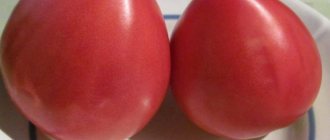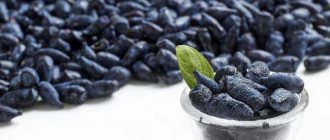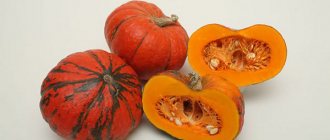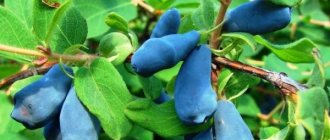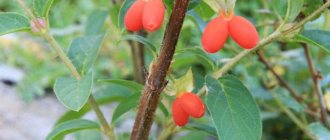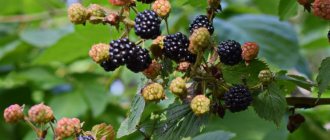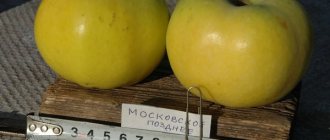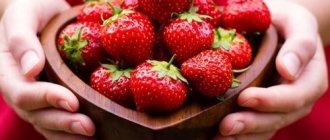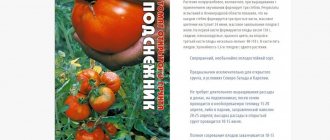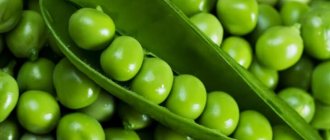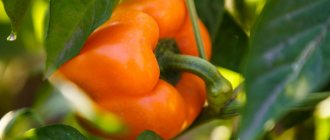Honeysuckle is a perennial shrub that bears juicy fruits. The plant comes in two types. One of them is an edible garden one. The second is a poisonous wild one. The wild shrub is also called wolfberry. It is easy to recognize by its spherical fruits. They are red, black or orange. They cannot be eaten. Another thing is garden honeysuckle. This is a very healthy dark blue berry. Its bizarre elongated shape vaguely resembles a plum.
Planting honeysuckle in the garden is not difficult. It can grow without problems in regions with cold climates. Breeders have developed different varieties of crops for cultivation in Siberia. The berry is one of the first to ripen in the summer. The delicious fruit contains a huge amount of useful substances, microelements, and vitamins. The berries are consumed fresh, and jams and preserves are prepared from them. The plant blooms very beautifully. The aroma of flowers is delightful. The crop is grown as a garden decoration.
Important! Those who grow honeysuckle do not suffer from hypertension. Berries lower blood pressure, relieve headaches, and cleanse blood vessels.
Requirements for choosing a honeysuckle variety for Siberia
First of all, it is important to choose a seedling: not only future productivity depends on it, but also the plant’s resistance to low temperatures. Three-year-old specimens with elastic branches are suitable - there must be at least three of them. The root system is branched, with an abundance of small white roots.
Attention! The main requirement is frost resistance. Most released varieties can withstand temperatures down to -50°C.
Preferable varieties are resistant to diseases: white spot, powdery mildew, cercospora. The strong immunity of honeysuckle makes it easier to care for and increases productivity. When choosing, pay attention to the ripening period and yield, taste and appearance of the fruit, purpose and care requirements.
Honeysuckle propagation
Like most shrubs, honeysuckle in Siberia can be propagated both by seeds and vegetatively. If it is necessary to obtain seedlings with the same characteristics as those of the mother plant, then the seed method is not used. Seedlings obtained from seeds, for the most part, do not retain varietal characteristics. Therefore, this method is used only for scientific purposes; mainly, it is used by breeders when breeding new varieties. Gardeners in Siberia use vegetative methods, which include cuttings, propagation by layering (air or root) and dividing the bush.
Honeysuckle cuttings are cut in summer from annual non-lignified shoots. The best time for cuttings is determined experimentally, depending on the maturation of the growth; it should remain green, but at the same time break well. Approximately this time falls on the second half of June. The cutting is a part of a shoot 12-15 cm long with one internode and a pair of leaves, the lower cut is made oblique, the upper cut is straight. The leaves located below the node must be torn off, and those located above must be cut in half to reduce moisture evaporation.
You can root cuttings directly in specially prepared moist soil, which contains peat and sand (1:3). The cuttings are planted at an angle of 45° towards the south, deepening to the middle of the internode. The bed or planting container is covered with glass or film and isolated from direct sunlight. In such conditions and while maintaining constant substrate moisture, the cutting forms its own root system, the formation of which will take from 2 to 3 weeks. Gradually the shelter is removed, first temporarily, and then completely. Cuttings rooted in the garden bed must be covered during the first winter and transplanted to a permanent place after a year.
Honeysuckle cuttings can be rooted in water and then planted in a substrate
Important! Cut green cuttings can first be kept in a root formation stimulator for 14-16 hours and then placed in water. After the roots appear, they can be transferred to the soil substrate.
Honeysuckle bushes that have reached the age of 8 years can be divided. In this case, the plant is completely dug up and cut into several parts, each of which should contain several healthy shoots with their own roots. In Siberia, this procedure is carried out in the fall, after the end of the growing season. The cuttings need to be rooted immediately.
Dividing a bush is a simple and reliable way to breed the desired variety of honeysuckle.
The same is done with honeysuckle root cuttings. The young shoots are cut off from the mother bush along with part of the root and planted in a new place.
To obtain aerial layering of honeysuckle, one of the side shoots is bent to the ground and covered with soil. Gradually the branch will take root and sprout its own shoots. After a year, the shoot can be cut off from the mother bush and transplanted to the desired location.
Important! The soil in the place where the cuttings are rooted should be constantly moist.
A selection of large and sweet varieties for Siberia
Some varieties are ideal for processing, others for fresh consumption.
To choose a suitable plant, it is advisable to study the weight and shape of the fruit, color and taste, care requirements and cultivation characteristics.
Azure
A universal mid-season variety. The bushes are medium-sized, 1.5–2 m high, thin shoots, large leaves. The berries are elongated-oval, average weight - 1 g. The skin is durable, rich blue in color with a white-blue coating. The pulp is tender, the taste is sweet and sour, with a blueberry aftertaste, the aroma is pronounced. Tasting score: 4.5 points out of 5.
Lazurnaya ripens in June and is unpretentious in care. Productivity is from 1 to 2 kg, depending on the age of the bush. The variety is partially self-fertile, which increases productivity. One of the advantages is the weak shedding of berries after ripening.
Kingfisher
Mid-late dessert variety. The shoots are medium-sized, the crown is compressed, the leaves are matte green. The berries are blue, oval-round, with a thick tip. There is a faint blue coating and pubescence. The taste is sweet, without bitterness, pleasant. Rating: 4.8 points out of 5. Fruit weight: about 1.1 g.
The productivity of Kingfisher is up to 2 kg per bush per season. The skin of the berries is thin, so they are used fresh or processed = the crop is not suitable for transportation. The variety is winter-hardy and is rarely attacked by insects. Moderately resistant to drought and heat.
Siberian
Sibiryachka honeysuckle is harvested in June. The bushes are medium in size, the shoots are thin and elastic, the flowers are pale yellow. The weight of the berry is about 1 g, the color is blue-violet, with a blue bloom. The flesh is tender and elastic, the taste is sweet and sour. Taster rating: 4.9 points. A young bush produces about 0.5 kg of honeysuckle per season, an adult - from 3 to 4 kg.
Attention! In the third year after planting, honeysuckle is thinned out and shaped. Old branches are shortened by 20 cm. If this is not done regularly, the bush will lose its decorative appearance and the yield will decrease. It is important to pay attention to the lower branches: they should be well lit. This is where most of the flowers are laid.
The Siberian rarely gets sick. Disadvantages include the fruits falling off, so they are harvested immediately after ripening.
My joy
Medium-growing, medium-late variety. The shape of the berries is round-oval, the color is blue-violet, there is a slight bloom. Weight - 1 g, some specimens reach 1.5 g. The taste is sweet, the flesh is tender and juicy, without bitterness or sourness. Tasting score: 4.6 points.
In the fourth year after planting, the yield reaches 2.3 kg per plant. Among the advantages of the variety are winter hardiness and low fruit shedding. The crop's tolerance to heat and drought is average.
Juices and compotes, tinctures and fruit and berry desserts are prepared from honeysuckle. The pleasant taste of berries goes harmoniously with ice cream, fresh baked goods, and refreshing drinks.
Volkhova
Mid-season variety for universal use. The shoots are thick and strong, light green in color. The height of the bush is up to 2 m. The berries are round-oval, with a sharp tip, the skin is medium thick. Weight - about 0.8 g, color blue-blue, with a white coating and slight pubescence. The taste is sweet, tasting score - 4.7 points out of 5.
The skin of the berries is strong, so the crop is used for transportation and storage. From 1.5 to 3 kg of fruits are harvested from a bush, depending on weather conditions and the age of the plant. The variety is frost-hardy, disease-resistant, and is slightly affected by pests. Requires pollinators.
Nymph
A mid-early variety, unpretentious to grow, rarely damaged by insects. The height of the bush is about 1.5 m, the crown is spreading and round. The berries are large, the weight of one is from 1 to 3 g, the shape is elongated. The surface is slightly lumpy blue-blue. The skin is of medium thickness, the flesh is sweet and aromatic, without bitterness. Taste rating: 4.7 points.
The harvest ripens by mid-June, the shedding is weak. The variety is early-bearing - the fruits are harvested 3 years after planting. To increase productivity, it is recommended to plant Nymph on loamy soils.
Fire opal
The variety is mid-early and ripens at the end of June. The bushes are spreading, medium-sized, height - up to 1.7 m. The leaves are large, dark green. Berry weight - 1.2 g, oval shape, blue-black, rich color. The taste is sweet and sour, rating - 4.5 points.
Attention! Honeysuckle is planted in early autumn and early spring. The depth of the hole should be at least 1 m, the distance between the bushes should be at least 1.5 m.
The ripening period of Fire Opal is extended - the harvest is harvested several times per season. The bush bears fruit 3 years after planting. Resistance to diseases and frost is high, the berries are universally used.
Moraine
Mid-early dessert variety. The bushes are vigorous, the shoots are long brown-green. The berries are one-dimensional, elongated, weight - about 1 g. The color is blue-blue. The taste is without bitterness, sweet and sour. The pulp is tender and pleasant, aromatic. Tasting score: 4.5 points.
Ripening occurs at the end of June or beginning of July. Productivity is about 1.5 kg of honeysuckle per season. Moraine is self-sterile, so the varieties Blue Spindle, Blue Bird or Viola are planted nearby.
Blue spindle
Berel
Early ripening honeysuckle Berel is resistant to shedding. The bushes are medium-sized, the crown is small. The weight of the berry is from 0.5 to 1 g, the shape is conical. The color is blue-black, rich, with a bluish tint. The taste is sweet and sour, balanced. The variety is early-bearing - the first harvest appears 2-3 years after planting.
The advantages include transportability and stable yield: every year summer residents collect up to 3 kg of berries from a bush. Ripe fruits are universal in use: they are used for processing, sale, and fresh consumption.
Growing and care
Honeysuckle bushes in a permanent place are watered abundantly, weeded, fed, and pruned. Watering is carried out several times a week or more often. The crop bears fruit better if the soil at the roots is moist. After watering, the soil is loosened and weeds are removed. The owner of the site needs to pay special attention to weeding, since the roots of the bush are shallow, and weeds deprive them of nutrition. In July, the plant begins to hibernate, from this time watering can be canceled or done rarely.
Fertilizing is carried out in the same sequence as for other berry bushes. A solution of nitroammophoska and complex mixtures are suitable for this.
Note! The first pruning of honeysuckle takes place 6-7 years after planting. The procedure is performed before winter. The next rejuvenation of the bush should be carried out after 5-6 years.
The varietal honeysuckle shrub is able to survive harsh winters when temperatures drop to -50. However, he still needs pre-winter preparation. To do this, the plant needs to be fed, and when snow falls, it needs to be sprinkled with it thoroughly.
Flowering culture
It is no coincidence that honeysuckle has recently become an increasingly popular crop. It is not difficult to grow. In May, beautiful bushes will delight the owner of the site with delightful flowers with a pleasant aroma. In June, juicy, tasty fruits will ripen on the plant. Blue-blue honeysuckle berries ripen earlier than strawberries and other berry crops.
Early varieties of honeysuckle for Siberia
Early varieties are most often used in cooking: the berries are preserved in jars, ground with sugar, and jams and juices are made from them. The fruits ripen in mid-June; the plants are distinguished by strong immunity and ease of cultivation.
Important! Most early varieties are not suitable for long-term harvest storage and transportation.
One of the popular early ripening varieties is Gerda honeysuckle. Partially self-fertile, universal in use. The bushes are spreading, height - 1.5 m. The shoots are straight and matte, the leaves are green. The weight of the berry is about 0.7 g, the color is blue-black, with a blue coating, the shape is oval. The taste is sweet and sour, pleasant, the pulp is medium dense. The first berries appear on the bush 2 years after planting. Productivity is about 2 kg per plant per season. They use not only berries, but also leaves: vitamin herbal tea is brewed from them.
Siberian summer residents also choose Narym honeysuckle for planting. The bushes are compact and take up little space on the site. The weight of the berry is up to 1 g, the shape is oval-round, slightly elongated. The peel is medium thick, blue-violet in color, with a blue tinge. The taste is sweet and sour, tasting score - 4.8 points out of 5. Narymskaya is frost-resistant, rarely more viral and fungal diseases.
Late
Late honeysuckle is used for storage and transportation and is grown on an industrial scale. The berries have a thick skin that protects them from cracking and spoilage.
One of the best late varieties is Provincialka. The bushes are weak-growing, the shoots are curved. The berries are large: the weight of one reaches 1.9 g. The shape is oval, the skin is dark blue, with a coating. The pulp is sweet and juicy, the taste is pleasant berry, tasting score - 5 points. The bushes are unpretentious in cultivation, resistant to drought, diseases and pests, and bear fruit consistently.
Another late-ripening variety is Selena. The height of the bush is 1.7 m, the crown is compressed. The weight of the fruit is up to 1 g, the shape is elliptical, the color is blue-black, with a blue bloom. The taste is sweet and sour, with a slight bitterness. Honeysuckle ripens in the second half of June, rarely gets sick, and does not fall off. The pulp has a pleasant taste and contains vitamins C (18 mg/%) and P (1829 mg/%).
Features of growing in Siberia
Experienced gardeners recommend choosing three-year-old seedlings with an open root system for planting in regions with harsh climates. The best time to plant them is late spring or early summer. Planting will be effective only in cool, rainy weather and subsequent abundant watering. Berries on the bush can form as early as the next year, and some varieties bear fruit the same year. You should choose seedlings with large, but not long roots, dense skin and without dark spots on the shoots.
Recommendation: Annual seedlings should be planted in the fall, approximately 3-4 weeks before the onset of sustained cold weather. After planting, the soil under the plant must be compacted and mulched with straw or sawdust.
Landing
The hole for planting Siberian varieties of honeysuckle should be about a meter deep, since during the summer it sags and is filled with breathable compost. The soil contains all the necessary nutrients and biologically active substances for rapid growth and formation of young shrubs. When planting in regions with harsh climates, the following agricultural practices should be used:
- lay rough pebbles or cobblestones at the bottom of the hole for drainage;
- when placed in a hole, the soil should cover the lower shoots of honeysuckle;
- When planting, you cannot apply any mineral or organic fertilizers.
The first fertilizing is carried out only a year after planting. Excessive frequent application of fertilizers will lead to an increase in green leaf mass and a complete or partial absence of flowering and fruiting.
Edible varieties
Honeysuckle is divided into edible and decorative. The first is grown for practical purposes: for food or processing, the second - for decorating a summer cottage or creating a hedge.
The following edible varieties are popular:
- Velvet. A vigorous bush with straight shoots. The berries are oval, dark blue, weigh about 1 g. The taste is delicate, sweet and sour, with a slight bitterness. The variety is winter-hardy and is not damaged by insects and diseases.
- Bakchar giant. Mid-season variety with extended fruiting. The berries are large, weigh up to 1.8 g. The skin is blue, with a waxy coating, the taste is sweet and sour, pleasant. The tasting score of the Bakchar giant is 4.8 points.
- Yugana. A universal mid-season variety. The weight of the fruit is 1.2–1.8 g, the shape is pitcher-shaped, the color is blue, with a bloom, the peel is thick. The taste is sweet and juicy, the aroma is pleasant and refreshing. Taster rating: 4.8 points. Yugana is resistant to frost and drought, and is weakly affected by pests.
Decorative
Decorative honeysuckle decorates the garden with a lush and green crown, original inflorescences, and attractive fruits.
Plants are frost-resistant and do not require much attention:
- Nikolushka. The height of the plant is up to 3 m, the crown is pyramidal-spreading, curved shoots grow downwards. The flowers are original, white-cherry variegated color. The buds are white-green, with a crimson tint. Nikolushka blooms in mid-May. A winter-hardy and heat-resistant variety is used to create hedges.
- In memory of Skvortsov . The height of the bush is 2.5 m, the fruits are round, red, and do not fall off. The flowers are white with a bright pink spot, the peduncle is crimson, the anthers are a rich yellow color. The buds bloom quickly. Honeysuckle is used for landscaping and garden decoration.
- Golden. A separate type of honeysuckle. The spreading shrub blooms in late May-June. The leaves are dark green, the flowers are golden, and have a rich sweet aroma. The berries are red, round, diameter up to 8 mm. The golden one does not get sick, is easy to care for, and gets prettier every year.
History and properties of honeysuckle
The very first varieties of honeysuckle appeared in cultivation only in 1980. However, almost 40 years later, at least 85 edible varieties were known in breeding.
The main advantage over other varieties of berries is faster and earlier ripening. In the Urals, fully ripe berries can be picked already in mid-June.
History shows that the berries sometimes ripen at the end of May. The liquid can be collected until the beginning of autumn.
Not everyone knows this, but honeysuckle has beneficial properties, in particular, it contains many vitamins, thanks to which you can maintain your figure in ideal shape.
It is also used as a medicinal food. The berries contain only 9% sugar and 1.5-2.5% acidity.
The berries also contain active ingredients such as rutin, catechins, leukoanthocyanins, etc.
The liquid can have different tastes - from slightly sweet to sour and from sweet to bittersweet. And the bitterness in the berries can be quite strong, as if they were sprinkled with red pepper.
For example, blue berries with spindles, sweet in taste, with “spicy” mustard. Those who like “sour” will love the variety of Leningrad giant honeysuckle (in this article you can see which varieties of honeysuckle are the sweetest).
Interesting: sometimes the taste of zhimur can be similar to strawberries.
The shape of different types of honeysuckle also varies. They can be round, elongated, drop-shaped or liliid. But the surface of different types is no different; they all have a hilly surface.
How to choose the right variety
Decorative varieties are chosen to decorate the garden: colorful berries and flowers look attractive in any area. Early edible varieties with thin skins are planted for fresh consumption; late varieties are planted for storage and transportation.
Those who love a tart taste will like plants with bitter berry pulp, while others will like sweet and sour-sweet ones. These and other characteristics are clarified by the seedling seller. It is important to pay attention to the timing of planting and ripening, to find out whether the plant often gets sick or not.
Recommendations for choosing seedlings
Here are some recommendations that may be useful when purchasing honeysuckle seedlings:
- You should buy 2-3 year old bushes. If you buy young shrubs, you will have to wait a long time for harvest. In this case, the harvest will be in 2 years;
- Note the flexibility of branches. They should be easy to bend and not dry out. There should be no obvious damage;
- don't think that peeling the bark is bad. This is normal for honeysuckle honeysuckle honeysuckle honeysuckle. All varieties flake;
- Carefully study how well developed the root system of the bush is. It is best if the roots are massive and more collected. Also check the bush for buds. If you don't have buds, it's best to pass by these bushes and look at other possibilities;
- You shouldn't just buy seedlings of one variety. It is best to combine three varieties at the same time. This way, you can easily propagate honeysuckle in the future. Of course, honeysuckle and seeds can be propagated, but it is better not to use this method. It will take too long and require too much time and effort.
Pests and diseases
Aphids on honeysuckle.
The liquid is almost immune to disease, but suffers from pest infestation:
- Aphid;
- honeysuckle fingertip;
- pink leaflet;
- sawmill with gooseberries;
- bird.
To avoid pests, honeysuckle bushes in the spring, before the berries ripen, must be sprayed with insecticides.
As honeysuckle matures early, insecticide loads should not exceed five days (more information on honeysuckle disease and pest control can be found here).
This is interesting: green soap is added to the solution to improve adhesion to the leaves.
According to those who already grow the Bakhchar giant honeysuckle in their garden, it deserves attention. The high frost resistance of the variety is its undeniable advantage.
The shape of the crown is ideal for picking berries. The berries themselves are very large and have an excellent taste. All these advantages of the variety are very attractive for growing this variety.
Watch an overview video of the Bakchar giant honeysuckle:
Page 4
Liquid, originally a wild shrub, in its modern “cultivated” form, is today becoming increasingly popular among professional and amateur gardeners.
In this context, gardeners are wondering which varieties of edible honeysuckle are optimal for growing at home.
Here we will try to briefly describe the best representatives of this berry crop, which are sold in stores and nurseries, and explain how to care for them.
Good to know: The Honeysuckle garden plant is the hardiest crop grown on the property. In winter, plants can withstand extreme cold (-45 to -47°C) without damage.
Landing
The most optimal time for planting berry bushes is autumn. In winter, honeysuckle will be able to rest peacefully and settle down in a new place. When choosing seedlings, preference is given to honeysuckle, varieties of which are intended for Siberia. The best age for seedlings is 3 years. Plants should be healthy, without damage, with thin branches that are not too long.
Preparing to plant honeysuckle involves choosing a good location and working with the soil. Siberian honeysuckle should grow in a sunny bed, the distance between bushes is 2 meters.
Important! The hole for the seedling is prepared several months before planting or in the spring. It is fertilized with ash, potassium sulfate, humus, and double superphosphate. Dig up 2-3 times, remove weeds.
Planting is expected to take place in September. The seedling also needs to be prepared for placement in the soil. To do this, its roots are straightened and sprinkled with earth. The seedling is placed in the hole so that the lower branches are 5 cm above the ground. It is not recommended to fertilize the bush during planting. The soil is well watered and mulched with sawdust or peat.
